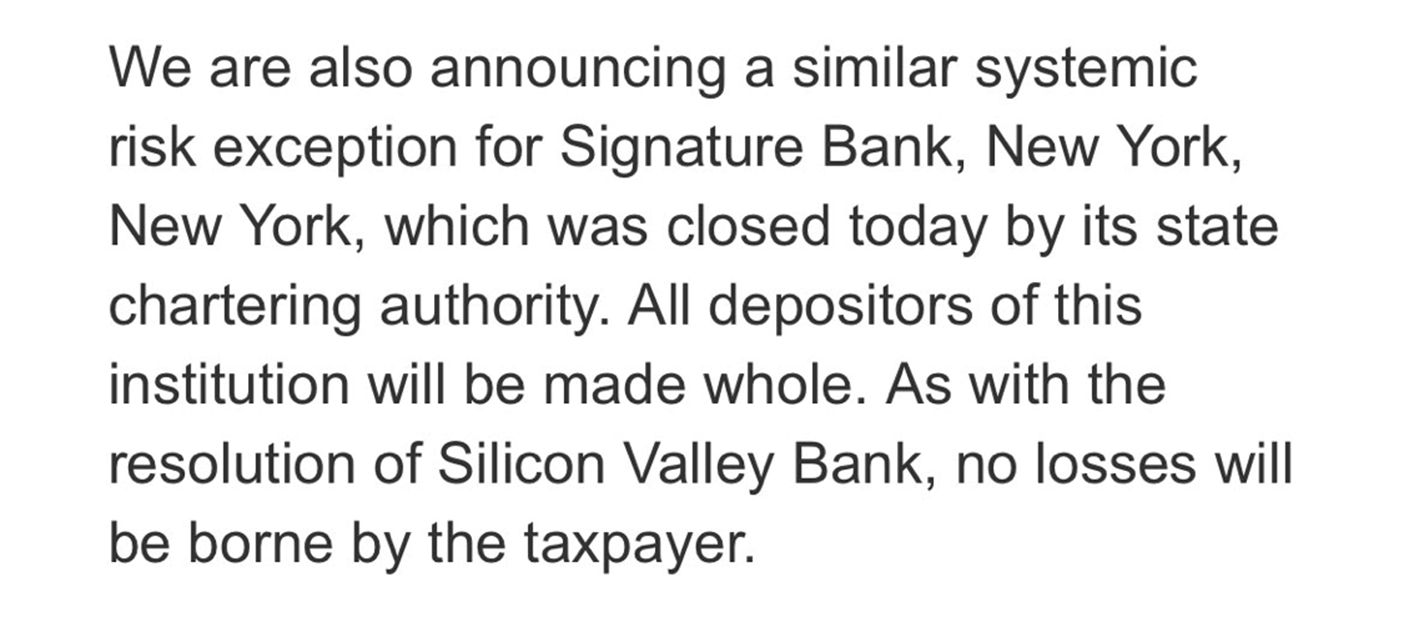
Banks Fail + Depositors Whole = Confidence Restored?
Bank failures are major events but they have occured before and will occur again. There will be jobs lost, reputations ruined and shareholder investments gone. A terrible string of events but an important reminder that this can occur at any poorly run company, especially one that takes too much risk. This is also a reminder to our clients that concentration risk is real, and the reason we continue to preach the importance of diversification, risk management and proper planning.

What's maybe more important is that regulators stepped in quickly with swift action to calm the potential of a bigger problem, which is loss of confidence and a run on small and regional banks, similar to the 1930s. The FDIC and the Federal Govt stepped in to make depositors whole. Reminder that the FDIC provides insurance coverage on the first $250,000 per depositor account (See: FDIC Insurance Limits at a Glance) which is funded by member banks, not the taxpayer. The bigger concern is cash above the FDIC insurance limits, which the Federal Govt has decided to make consumers whole. These decisions were made quickly, and money was made available as early as today, after a few of these banking institutions were shut down over the past few days. This provides confidence in the banking system, which is extremely important.

Bank Failures - What Happened?
The collapse of Silicon Valley Bank (SVB) was the first FDIC-insured bank failure since 2020 and the second largest in history. This was followed two days later by the failure of Signature Bank, the third largest in history. Just a few weeks earlier, these two publicly traded companies had the 14th and 18th largest market capitalizations among U.S. banks, respectively. Silvergate, a smaller bank active in the crypto industry, also failed the same week, but through an orderly liquidation.
From a market and economic perspective, the main question is whether there is wider systemic risk to the financial system. This episode reveals that these particular banks grew too aggressively and with too little risk management as tech valuations rose and crypto prices rallied over the past several years. While this worked well in a bull market, the reversal of these trends in 2022 made these banks vulnerable to classic bank runs.
- Rapidly rising interest rates and Fed rate hikes over the past year created financial stresses on bank balance sheets. Bonds had their worst performance in history in 2022, driving unrealized losses on investment assets including U.S. Treasuries, as shown in the accompanying chart. Whether banks need to book these losses depends on how these securities are accounted for, but this worsens as banks face pressure on deposits. Thus, SVB and others found themselves with assets that were worth far less as rates rose.

- SVB’s concentration of tech and startup customers made it vulnerable as conditions deteriorated for that sector, just as Silvergate and Signature Bank were exposed to the slowdown in the crypto industry. SVB tried to plug this gap by raising fresh capital, but this backfired since it highlighted the liquidity and solvency issues it faced. Like shouting "fire" in a crowded theater, once there is the perception of solvency problems, a classic bank run can occur swiftly, which can then become a self-fulfilling prophecy. To a large extent, this played out publicly as many in the startup and VC communities urged companies to move their funds.

While government actions are always controversial and subject to political debate, moves by Treasury, the Fed, and the FDIC to backstop customer deposits across these banks will likely help to prevent contagion effects across the system. At the same time, it does not directly address the underlying issue of impaired assets which depends on the quality of risk and asset/liability management at each bank. However, the risk that unrealized losses become a solvency issue is mitigated for larger, more diversified banks who are less reliant on deposits, have a stronger deposit base, and maintain higher amounts of capital.
Sandbox will continue to monitor the evolving situation and communicate with you on a timely basis. If you have questions or would like to discuss your individual situation, please contact us anytime. Have a great week.
